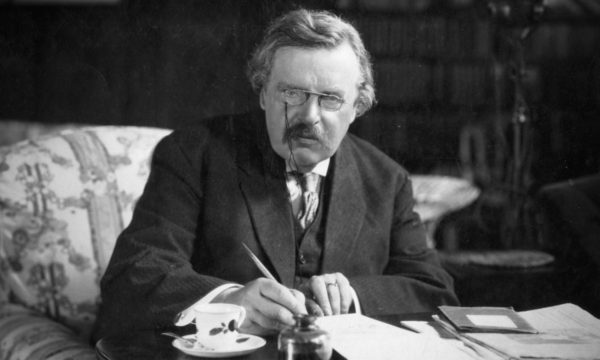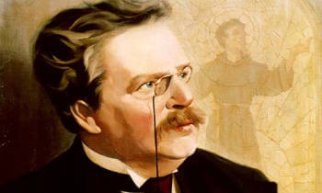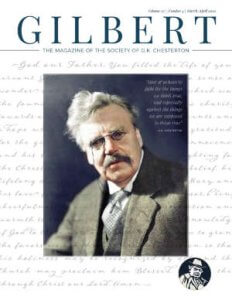This unique book was the bright idea of a writer from Ceylon who visited England in the late 1920’s and became friends with Chesterton. J.P. de Fonseka considered Chesterton a Master of Ceremonies to a whole banquet of authors past and present. Not just a Master but a Grand Master. He decided to collect Chesterton’s introductions to books by others and put them in one volume, showing how Chesterton is the surest guide leading the way into the world’s great literature.
J.P. de Fonseka chose 37 introductions, but his selections represent less than one-fourth of the introductions that Chesterton wrote to books by others. What is astonishing is not the number of introductions he wrote, but that he wrote 200 introductions on such different subjects. The various prefaces reveal the great confidence writers and publishers had in Chesterton, but also his generosity with his genius and his pen and even his name. Many of those books are obscure to say the least, such as the obscure volumes of poetry (A Vision of Life by Darryl Figgis, The Little Wings by Vivienne Dayrell), obscure memoirs (My Circus Life, Recollections of an Octogenarian), obscure regional histories (The Penn Country of Buckinghamshire), obscure contemporary criticism (Practical Pacifism and Its Adversaries, The New World of the Theatre), obscure fiction (The Wrong Letter by W.S. Masterman), and obscure commemorative fundraisers (The Blinded Soldiers and Sailors Gift Book, The Book of the Queen’s Dollhouse). In most of these books, the introduction by Chesterton is the only thing worth reading.
But the introductions selected by de Fonseka are from books that are usually well known and by notable authors, such as Hilaire Belloc, Cecil Chesterton, Samuel Johnson, James Boswell, Jane Austen, Oliver Wendell Holmes, Dickens, Thackeray, Aesop, and whoever it was who wrote the Book of Job. We even have an introduction by Chesterton to one of his own works — the advance issue of G.K.’s Weekly. And in spite of the excellence of this collection, there are still some noteworthy omissions, such as the introduction to Bunyan’s Pilgrim’s Progress and Fulton Sheen’s first book, God and Intelligence (though in 1929, J.P. de Fonseka might be forgiven for not predicting the coming fame of the future archbishop).
In GKC as MC there are three introductions that touch on Dr. Johnson, in which we can see why Chesterton compares so well to the famous man of letters who “touched nothing that he did not adorn.” There are four introductions that touch on Dickens, including a piece on “A Christmas Carol” that recognizes not just its greatness but its prophetic nature in that the modern Scrooge now wants to “decrease the surplus population” before it is born. There is also on introduction on George MacDonald in which Chesterton praises that great ecumenical writer as one of the “morning stars of the Reunion.” And by way of both contrast and affirmation, he considers the unique and Catholic light shining from the Cure D’ Ars, St. John Vianney, as almost heaven’s own rebellion against the whole 19th century.
Chesterton’s response to this collection of what he thought had been “fortunately forgotten fragments” was to “shudder” at his “crudity of expression.” And yet he admitted that he was pleasantly surprised to see that his fundamental convictions had not changed. He realized that his recent conversion to Catholic Church “did not come to destroy but to fulfill.” And it was indeed Chesterton’s consistency of thought, no matter what the subject matter, that de Fonseka wanted to put on display. Besides, it saves having to buy 37 different books in order to read the bit of Chesterton that each book contains.
Without question, the highlight of GKC as MC is the Introduction to the Book of Job. Chesterton must have deeply contemplated the Book of Job, the ancient Hebrew poem older than the Hebrews themselves. It is the book of the Bible Chesterton refers to most throughout his writings. The mystery of suffering is the most tremendous mystery of existence, save for existence itself. There is no other work that so timelessly and tellingly delves into this mystery. Its conclusion is still surprising, so surprising that most people who think they know what happens don’t know at all. After Job’s agonizing ordeal, beseeching God not just for relief but for reasons why, God does not appear and explain it all in a neat package. No. God appears and asks questions of his own. Chesterton makes the bold claim that man is most comforted by paradoxes, comparing the worthless answers and advice from Job’s friends to the cryptic questions from God himself: “The Riddles of God are more satisfying than the solutions of man.” If that is not profound enough, consider the paradox that Job suffers more than all men not because he is the worst of men, but because he is the best. Chesterton leaves it up to us to figure out whose wounds are pre-figured in the wounds of Job.





